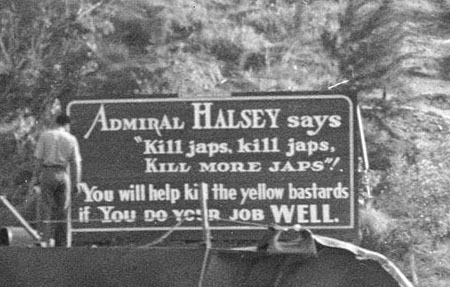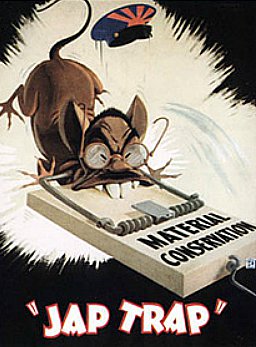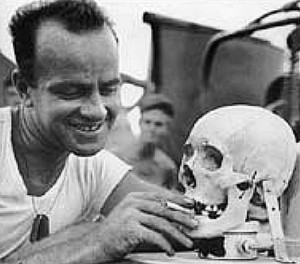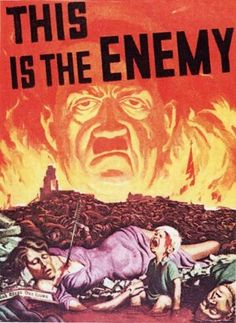
THE UNTOLD STORY OF AMERICAN WAR CRIMES IN JAPAN (PART 1)
Thomas Goodrich / Slightly abridged by Lasha Darkmoon, with notes and comments
(SCROLL DOWN)
*
*
*
*
*
*
*
*
*
*

“It was not just the marines who committed countless atrocities in Japan,
virtually all American servicemen partook.” — Thomas Goodrich
Introductory Note by Lasha Darkmoon
In regard to the mass rape and torture of 2 million German women in World War II — the subject of another article — it is now customary to assign maximum blame to the Soviet Union for this horrendous war crime: to Stalin’s Red army, consisting of soldiers belonging to many ethnic groups. In order to spare the blushes of the white Russians, the finger of blame has now been pointed by anti-Semites at the vast numbers of Jews within the Red army—said to number roughly 200,000. Solid proof that most of the Red army rapists were Jews, however, is sadly lacking. You may suspect heavy Jewish involvement if you don’t like Jews, but you cannot prove it.
The same applies if you point the finger of blame at the Asiatics within the Red army : at the huge number of Mongols, Tatars and Chinese. Again, solid proof of larger-than-average Asiatic guilt is lacking. So if Germany is ever to obtain financial compensation (at some future date) for the mass rape of its womenfolk during the 1944-1947 period, it will have a wide range of rapist groups to choose from : the Russians, the Jews, the Mongols, the Tatars, the Chinese, the Americans, the Brits, the French, and the Moroccans in the French army. They will all have to pay.
This is not a digression. I am coming to the point. I am fully aware that this article is about American war atrocities in Japan and not about Russian war atrocities in Germany. My point is simply this: while the Russians were raping and pillaging Germany, the Americans were raping and pillaging Japan. These atrocities against the helpless and innocent civilian populations of the two defeated nations, Germany and Japan, were taking place simultaneously at the tail end of World War Two and in its immediate aftermath. “Just as the Allied air forces were targeting cities and civilians in Germany,” Goodrich tells us, “so too was the US air force incinerating the women and children of Japan.”
Goodrich has written extensively about both these national holocausts, but it is the holocaust against the German people only that has impinged on the consciousness of many people in the West, after a raft of books on the subject, notably Goodrich’s own widely acclaimed tour de force Hellstorm: The Death of Nazi Germany, 1944-1947. In contrast, the Japanese holocaust remains relatively unknown. The untold story of the rape of Japan, though told to a few, has yet to be told to the many.
When it comes to mass rapes committed in war, the prevailing myth among most Americans goes something like this: “Yes, our soldiers have been guilty of rape in war time, but we’re not that bad compared to the Russians or lots of other nations. Relatively speaking, we’re pretty well-behaved around women. We do our best not to rape too many of them!” The Brits would probably echo these words. They, too, are chivalrous knights in shining armor who would never dream of raping women en masse—except, of course, in exceptional circumstances.
A quick look at what the Americans got up to in Japan—the subject of the groundbreaking article by Thomas Goodrich which you are about to read—will cure you of any delusions of American chastity and sexual self-control. When the Americans got to Japan, they treated the Japanese women with as much merciless ferocity as Stalin’s Red army soldiers treated the German women who fell victims to their maniacal lustmurder. All my delusions of American righteousness and uber-nobility flew out of the window when I read this mind-altering article. “So,” I told myself grimly, “Americans have feet of clay too! They’re just as bad as the baddest of the bad!”
Part 1 of Goodrich’s article covers the general rape of Japan, Part 2 has more to say on the rape and brothelization of Japanese women who were to serve as “comfort women” for the American occupying forces. Goodrich cannot be praised too highly for his pioneering work in bringing to our attention the demonic nature of man in war time, and the depths of depravity to which man will sink when his mind is possessed by the unclean spirits that walk in darkness. [LD]
Part 1: The Rape of Japan
by Thomas Goodrich
As a child, I vividly recall a scene from an old war movie. The US Marines are storming some Pacific island and driving the terrified “Jap” defenders before them, much as safari beaters drive prey. The wild chase increases in momentum until the enemy is finally flushed from the trees and onto the beach. Halting their tanks, situating their machine guns for maximum effect, the marines open fire. Scores of Japanese are mowed down mercilessly. With no hope, with no escape, the survivors leap into the surf and try to swim for it. In a matter of minutes, there is not a living “Nip” among them.
Another scene I vividly recall seeing—and this only once—was a war documentary. A Japanese sailor is struggling in the water amid a flotsam of oil and debris, desperately trying to save himself. Clearly, he is a survivor from a recently sunk ship. The sailor is so close to the American naval vessel that I can see the fear and confusion in his face. Suddenly, from a point beyond camera range, bullets spray the water around the man. In a panic, the sailor begins swimming around and around in circles. Finally, a well-aimed bullet blows the young man’s head apart and he sinks silently beneath the surface.
In those old documentary films that cover World War Two in the Pacific, there is a very good reason why one seldom sees a live Jap in any of them, much less a prison camp filled with live Japs. Just as they were doing in Europe, Americans in the Pacific were taking no prisoners. The awful truth never mentioned in these films, or in any book, for that matter, is that the war with Japan from start to finish was a black flag no-quarter contest in which the rules of engagement were shockingly simple: If the Japanese won, they lived . . . if they lost, they died.
§
Millions raped, millions tortured, millions enslaved, millions murdered—truly the defeat of Nazi Germany was utter in its hate and hellish in its evil. It was, by all standards, the most savage and sadistic such defeat in human history.
Savage and sadistic as the war and ensuing Jewish “peace” in Germany was, nowhere was the terrible price of propaganda more evident than in the war with Japan. Unlike the Germans who not only looked and acted much like the Americans, British, French, and Russians, and shared a similar religion and culture, the Japanese were outwardly, at least, very different from their opponents in World War Two. Most graphic, of course, was race and the fact that the Japanese were Asians.
Although racially and culturally the enemy nations differed, prior to hostilities each side had no difficulty at all interacting amicably with one another. Indeed, a great degree of mutual respect, even admiration, existed among the two peoples.
All that changed in a blink, of course, on December 7, 1941.
 With the sudden attack on Pearl Harbor the American propaganda mill had no problem at all transforming those who had been universally acknowledged as a kind, courteous, and dignified people into a race of “dirty rats,” “yellow monkeys” and “sneaky Japs.” (See propaganda poster, right)
With the sudden attack on Pearl Harbor the American propaganda mill had no problem at all transforming those who had been universally acknowledged as a kind, courteous, and dignified people into a race of “dirty rats,” “yellow monkeys” and “sneaky Japs.” (See propaganda poster, right)
Thus, unlike the vilification campaign waged against Germans which took a great amount of time, effort and imagination, the job of demonizing the Japanese was simple. Once the US Government and the entertainment industry were up and rolling, the natural outrage and racial instincts of white Americans took over.
In the anti-Japanese furor that swept America following Pearl Harbor, in the hyper-heated madness to exact revenge for the attack, rare was that American who paused to consider that perhaps the impetus behind Pearl Harbor was the months of deliberate and humiliating aggression directed at Japan by the Franklin D. Roosevelt administration, including the embargo of vital raw materials without which Japan was doomed to collapse as an industrialized nation. Well before December 7, 1941, such sanctions were correctly viewed by the proud Japanese leadership, as well as the world, as a de facto declaration of war by the United States. Also, though few were aware at the time, it has long since been known that Roosevelt and others in the US government were well aware of the coming attack in the central Pacific.
Nevertheless, because of Japan’s military pact with Nazi Germany, Roosevelt and his Jewish “advisers” desperately hoped that backing the Japanese into a corner would provoke just such a response resulting in the United States entering the European war via the “back door.” In that case, the U.S. would then join with Britain and the Soviet Union to crush Hitler and Germany.
Thus, and almost on cue, the “sneak” attack at Pearl Harbor and the “date which will live in infamy” was used by the propagandists as a rallying cry to whip the American people—who had been decidedly against war—into a frenzy of anger, hatred and revenge.
If possible, the degree of American rage actually increased four months later when lurid details of the “Bataan Death March” reached the public. Bad enough in its own right, the chaotic 60-mile forced march of over 70,000 American and Filipino troops captured after the siege of Bataan was made infinitely worse by the fact that many of the prisoners were already near death from lack of food and medicine resulting from the long siege itself. Overwhelmed by the sheer number of prisoners, unable to provide transportation, the Japanese could do little else but watch as hundreds of prisoners dropped dead along the road during the long march.
 Describing them as “yellow vermin,” angry American artists created posters depicting the Japanese as everything and anything, save human—sneaking cockroaches, rampaging monkeys, large-fanged snakes, flapping vampire bats—an official U.S. Navy film described enemy soldiers as “living, snarling rats.”
Describing them as “yellow vermin,” angry American artists created posters depicting the Japanese as everything and anything, save human—sneaking cockroaches, rampaging monkeys, large-fanged snakes, flapping vampire bats—an official U.S. Navy film described enemy soldiers as “living, snarling rats.”
Reinforcing this dehumanization process were US political and military leaders. While General Eisenhower was busily murdering as many as a 1.5 million disarmed German prisoners in his secret death camps, Admiral William Halsey, US commander of operations in the South Pacific, seemed determined that not a single Japanese in his sphere of operations would survive to even reach a death camp.
“Kill Japs! Kill Japs! Kill more Japs!” Halsey exhorted his men time and time again. “Remember Pearl Harbor—keep ‘em dying!”
LD: This is almost an exact echo of the words used by Stalin’s Jewish propaganda minister, Ilya Ehrenberg, to get the Soviet soldiers of the Red army to kill all Germans indiscriminately, without mercy: “If you have not killed at least one German a day, you have wasted that day! Kill the Germans!… Kill the Germans!…Kill!” (See here)
Thus, in what was perhaps the worst-kept secret throughout all branches of the US military, it was this unofficial, yet understood, injunction to all American service men, high and low, that there was to be absolutely no mercy shown the enemy in combat.
“You will take no prisoners, you will kill every yellow son-of-a-bitch, and that’s it,” yelled a marine colonel to his men as their landing craft was about to touch shore on one Japanese-held island.
And thus it was, from the outset, from the initial island invasions of 1942, all the way down to 1945 and the nuclear holocausts at Hiroshima and Nagasaki, “no quarter” to Japan and the Japanese was the tacit understanding.
§
Despite the generally held belief that persists to this day, a belief which argues that all Japanese soldiers willingly, even eagerly, died for the emperor, relatively few young men embraced such an end if there was any hope of living. Like the American, British and Australian soldiers they were facing, most Japanese soldiers dreamed only of a day when the war was over; when they could return home in peace to family and friends; to marry a sweetheart; to raise a family; to tend a small garden; to enjoy life. Nevertheless, almost from the first, it soon became apparent to these young men that there would be, that there could be, no surrender. Wrote one American early in the war:
“Japanese were known to come out of the jungle unarmed with their hands raised crying ‘mercy, mercy,’ only to be mowed down by machine-gun fire.”
Time and again, on every contested island and every spit of sand, Japanese soldiers and sailors were slaughtered the instant they raised their hands and walked forward to surrender. After scores of such encounters in which breathless comrades in hiding watched, waited, then witnessed the massacre of their unarmed friends, fewer and fewer Japanese soldiers entertained even the slightest notion of giving up.
Ironically, though murdering a helpless enemy may have brought some sadistic satisfaction to Allied soldiers, the failure to take prisoners insured that thousands of comrades would also be killed by an enemy now forced to dig in and fight to the death. It is also a fact that as the war wore on and defeat became certain, more and more Japanese soldiers would have gladly surrendered if only they could.
“If men had been allowed to surrender honorably,” admitted one Japanese veteran late in the war, “everybody would have been doing it.”
In addition to the murder of prisoners, numerous other atrocities occurred. When one marine battalion captured a Japanese field hospital containing over 400 unarmed men, including patients and medics, all were slaughtered on the spot.
Other massacres occurred when hundreds, even thousands, of Japanese were driven onto beaches or small peninsulas where there was no hope of escape. Such wholesale “kill offs” reminded one Midwestern marine of nothing so much as the merciless massacre of jack rabbits driven into fenced enclosures back home.
“Nothing can describe the hate we feel for the Nips,” wrote an American lieutenant to his mother. “The destruction, the torture, burning & death of countless civilians, the savage fight without purpose—to us they are dogs and rats—we love to kill them—to me and all of us killing Nips is the greatest sport known—it causes no sensation of killing a human being but we really get a kick out of hearing the bastards scream.”
Remembered another witness:
“When a Japanese soldier was “flushed” from his hiding place . . . the unit . . . was resting and joking. But they seized their rifles and began using him as a live target while he dashed frantically around the clearing in search of safety. The soldiers found his movements uproariously funny. Finally . . . they succeeded in killing him. . . . None of the American soldiers apparently ever considered that he may have had human feelings of fear and the wish to be spared.”
Flame throwers were a particularly sadistic way to “roast rats.” Reported one observer: “I have asked fighting men, for instance, why they—or actually, why we—regulated flame-throwers in such a way that enemy soldiers were set afire, to die slowly and painfully, rather than killed outright with a full blast of burning oil. Was it because they hated the enemy so thoroughly? The answer was invariably, ‘No, we don’t hate those poor bastards particularly; we just hate the whole goddam mess and have to take it out on somebody.’”
“We are drowning and burning them all over the Pacific, and it is just as much pleasure to burn them as to drown them,” bragged William Halsey. As the admiral was well aware, his men were doing much more than just burning and drowning the enemy. . . .
With discipline lax or non-existent, those who wanted to torture, kill and mutilate, did. Desecration of bodies first began with the first islands invaded. Along a wide stream dividing the two armies on Guadalcanal, fresh arriving troops noticed decapitated Japanese heads stuck on poles facing across the river. There on the “Canal” and elsewhere, U.S. Marines tossed the dead and dying into open latrines while others laughingly urinated into the open mouths of the wounded.
The collection of ears, noses, fingers, and other body parts was a pastime many marines proudly participated in. Some strung the trophies and wore them like necklaces.
“Our boys cut them off to show their friends in fun, or to dry and take back to the States when they go,” said one man matter-of-factly.
Japanese skulls were another popular trophy. Some were sent home to friends, family, even sweethearts. Most heads, however, after being “cured” by ravenous ants or boiled in kettles to remove flesh, were then sold to eager naval personnel.
Bones were also collected. Some were carved to form letter openers for folks back home. Even the White House received one such present.
“This is the sort of gift I like to get,” laughed President Roosevelt. “There’ll be plenty more such gifts.”
 AMERICAN MARINE (left)
AMERICAN MARINE (left)
with Japanese skull trophy.
(A gift to his girlfriend?)
Understandably, when news reached Japan that the bodies of their sons and husbands were being wantonly abused and that the US president himself countenanced such atrocities, there was outrage.
The Americans were portrayed in the Japanese press as “deranged, primitive, racist, and inhuman.” Explained one American, himself equally outraged: “The thought of a Japanese soldier’s skull becoming an American ashtray was as horrifying in Tokyo as the thought of an American prisoner used for bayonet practice was in New York.”
Of all the trophies, however, none were more sought out than gold-capped teeth.
After any battle or massacre, the mouths of the fallen were often the first stop for many Americans. Like South Sea prospectors, fights broke out when “claim-jumpers” attempted to steal the bodies claimed by others. One excited marine felt he had struck it rich after spotting a dead enemy. “But,” according to a witness:
“. . . the Japanese wasn’t dead. He had been wounded severely in the back and couldn’t move his arms; otherwise he would have resisted to his last breath. The Japanese’s mouth glowed with huge gold-crowned teeth, and his captor wanted them. He put the point of his knife on the base of a tooth and hit the handle with the palm of his hand. Because the Japanese was kicking his feet and thrashing about, the knife point glanced off the tooth and sank deeply into the victim’s mouth. The Marine cursed him and with a slash cut his cheeks open to each ear. He put his foot on the sufferer’s lower jaw and tried again. Blood poured out of the soldier’s mouth. He made a gurgling noise and thrashed wildly. I shouted, ‘Put the man out of his misery.’ All I got for an answer was a cussing out. Another Marine ran up, put a bullet in the enemy soldier’s brain, and ended his agony. The scavenger grumbled and continued extracting his prizes undisturbed.”
Understandably, Japanese soldiers had no more desire to surrender and be tortured than did US soldiers fighting the Indians on the Plains of America a century earlier. Each fought to the finish, but each also saved the “last bullet” for himself.
If a Japanese soldier found himself surrounded with no way to escape or kill himself, he committed “suicide” by walking calmly back and forth along the enemy lines until a bullet found its mark. Sometimes ten, even twenty, Japanese would thus kill themselves simultaneously.
§
Once the Americans reached Saipan, Okinawa and other Japanese islands with civilian populations, mass rape was added to the menu of war crimes. Small wonder that a Japanese soldier, or civilian, for that matter, would do whatever it took to keep from falling into Allied hands. As one American revealed:
“The northern tip of Saipan is a cliff with a sheer drop into the sea. At high tide the sharp coral rocks are almost covered with swirling surf. The Japanese civilians and the surviving soldiers were all crowded into this area. Now one of the worst horrors of the war occurred. In spite of loud-speaker messages asking them to surrender, and assurances that they would be well-treated, they began killing themselves. Soldiers clutched hand grenades to their bellies and pulled the pins. Through our spotting scopes from our observation post I witnessed this sickening spectacle. One of the worst experiences of my life.”
Not only were there virtually no survivors among the 30,000 men of the Japanese garrison on Saipan, but two out of every three civilians—some 22,000 in all—were either murdered or committed suicide.
“We just blew it all up,” admitted one marine. “We don’t know if there were women and children or whatever, we just blew them up.”
“Japanese are still being shot all over the place,” reported an Australian late in the war. “The necessity for capturing them has ceased to worry anyone. Nippo soldiers are just so much machine-gun practice.”
A handful of prisoners did manage to get captured, of course, by accident if nothing else. All were spared solely for the information they might provide. When the interrogation was through, the subjects were of no further use. Wrote one witness:
“When they flew Japanese prisoners back for questioning on a C-47, they kept the freight door at the side of the plane open, and when the questioning of each man was concluded, he’d be kicked overboard before they reached their destination.”
 Of course, it was not just island-hopping marines who committed countless atrocities; virtually all American service men partook.
Of course, it was not just island-hopping marines who committed countless atrocities; virtually all American service men partook.
A Japanese sailor whose ship or submarine was sunk stood no better chance of survival than his comrade on shore. US naval vessels routinely shelled all life boats and machine-gunned any survivors still in the water. Overhead, Japanese pilots who escaped from burning planes were themselves murdered by Allied airmen as they struggled in their parachute harnesses.
As late as October, 1944, it was announced that a mere 604 Japanese were being held in Allied POW camps.
Just as the Allied air forces were targeting cities and civilians in Germany, so too was the US air force incinerating the women and children of Japan . . . (pictured, right)
Continued in Part 2 : Hiroshima, Nagasaki, and the Mass Rape of Japanese Women
Thomas Goodrich is a professional writer living on the Gulf Coast of Florida. His biological father was a United States Marine during the Pacific War, 1941-1945. Visit the author at ThomasGoodrich.com
http://www.darkmoon.me/2015/the-untold-story-of-american-war-crimes-in-japan-part-1/
